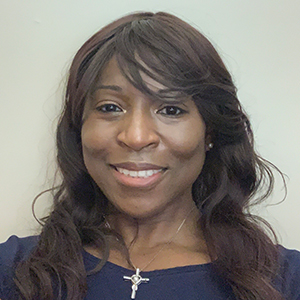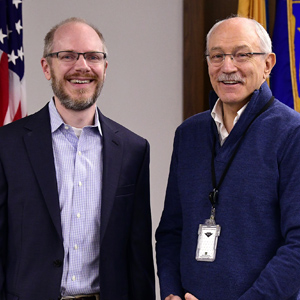“Great minds think differently,” said Marie A. Bernard, M.D., the National Institutes of Health (NIH) Chief Officer for Scientific Workforce Diversity, during her NIEHS Spirit Lecture, held virtually on March 2. “That is the catchphrase that motivates everything I do and that we do on my team.”
The Spirit Lecture began in 2002 as an annual event to recognize highly respected, outstanding women of notable achievement. Part of the institute’s Diversity Speaker Series, the lecture is held each year in March, in recognition of Women’s History Month.
Bernard leads NIH efforts to recruit, cultivate, and promote a diverse array of scientific talent, with the goal of advancing research innovation. She also co-leads the agency’s UNITE initiative, which aims to end structural racism in biomedical research.
 “We are at a tipping point,” Bernard said. “We have to make sure there aren't barriers based on demographic characteristics within the NIH workforce or beyond.” (Photo courtesy of NIH)
“We are at a tipping point,” Bernard said. “We have to make sure there aren't barriers based on demographic characteristics within the NIH workforce or beyond.” (Photo courtesy of NIH)Among numerous other career achievements, Bernard served as deputy director of the National Institute on Aging from 2008 to 2021. Her research focuses on nutrition and function in older adults, particularly minority populations, and she is a thought leader on the science behind scientific workforce diversity.
Evidence supporting diversity
According to Bernard, several studies reveal the need for diverse scientific perspectives. For example, a 2015 paper revealed that articles published by researchers of the same ethnicity were more often associated with lower-impact journals and fewer citations.
“Diversity makes a difference,” Bernard told attendees.
Lack of attention to diversity can constrain scientific advancement, she said, citing research published in January in the Proceedings of the National Academy of Sciences. Analyzing more than 5 million scholarly articles, the authors found a link between greater diversity among researchers and greater production of new scientific knowledge.
Compared with men of the same races, Latina, Black, and white women tended to have fewer publication credits in engineering, technology, mathematics, and physics, but more in health, psychology, and the arts. Asian men and women were roughly equal.
“The authors’ conclusion was that a different body of knowledge would be produced in the absence of these inequities,” said Bernard.
She noted that the results also reflect the reality of academic advancement.
“When you look at the professoriate, there's a fair amount of diversity at the instructor level, but as you approach the department chair level, there’s much less,” she said.
Aligning values with actions
So, what can be done to enhance diversity in biomedical research?
“Be transparent and accountable in hiring and promotion,” said Bernard. “Make diversity metrics public by posting data on research funding,” she added.
“My office has taken the lead in enhancing recruitment and retention by creating a search protocol to identify candidates for scientific positions,” Bernard noted. “We’ve provided curated lists of individuals for consideration and trained search specialists across NIH. We're not virtue posturing.”
Bernard also emphasized the importance of support programs, such as childcare and virtual work opportunities.
“All the wonderful diversity statements in the world are not going to make for institutional change,” she said. “We are aligning our values with our award system, with new performance expectations for diversity, equity, inclusion, and accessibility.”
The UNITE initiative is one example. It requires each NIH institute and center to develop a racial and ethnic equity plan.
“NIEHS is fully immersed in this, and my hat is off to you,” Bernard said.
Bernard told attendees that she would also like to build upon the NIH Distinguished Scholars Program (DSP), which is open to tenure-track researchers who have demonstrated a strong commitment to promoting diversity and inclusion. To that end, her office recently launched the 21st Century Scholars Program, which replicates principles of the DSP for extramural program staff.
High praise
Event organizers heralded Bernard, who received the 2022 Spirit Lecture Award.
“Her talk provided a wealth of information on NIH’s ongoing diversity efforts,” said NIEHS toxicologist Vicki Sutherland, Ph.D., who co-chaired the lecture committee with institute program analyst Suzy Osborne. “We were thrilled to honor Bernard with this year’s award.”
“Dr. Bernard embodies everything the NIEHS Spirit Lecture Award recognizes,” said NIEHS and National Toxicology Program Director Rick Woychik, Ph.D. “I can't think of a more highly deserving recipient.”
Citations:
Freeman RB, Huang W. 2015. Collaborating with people like me: ethnic coauthorship within the United States. J Labor Econ 33(S1):S289–S318.
Kozlowski D, Larivière V, Sugimoto CR, Monroe-White T. 2022. Intersectional inequalities in science. Proc Natl Acad Sci U S A 119(2):e2113067119.
Marie Bernard, M.D.: What Does Diversity Have to do With Science? - Spelman College
In February, Bernard gave a presentation titled “What Does Diversity Have to Do With Science?” during an online event hosted by Spelman College, a historically black liberal arts college in Atlanta, Georgia. (1:00:52)
(John Yewell is a contract writer for the NIEHS Office of Communications and Public Liaison.)









